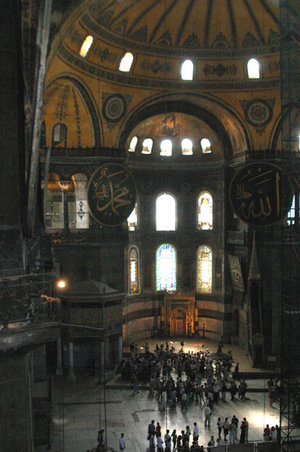Sfânta Sofia (Constantinopol)
| Acest articol (sau părți din el) este propus spre traducere din limba engleză!
Dacă doriți să vă asumați acestă traducere (parțial sau integral), anunțați acest lucru pe pagina de discuții a articolului. |

Hagia Sofia (Άγια Σοφία în greceşte), Biserica Sfintei Înţelepciuni, cunoscută si sub alte nume precum Sancta Sophia în limba latină, sau Ayasofya în limba turcă, este o veche catedrală ce aparţine de Biserica Ortodoxă a Constantinopolului, şi care se află în oraşul Istanbul din Turcia zilelor noastre. Ea a fost transformată în moschee de către turci, iar acum este utilizată ca muzeu. Este recunoscută universal ca una dintre marile clădiri ale lumii, reprezentând un punct de referinţă în istoria arhitecturii. (Numele bisericii este uneori greşit interpretat, ca şi cum ar fi numele unei sfinte cu numele de Sofia.)
Construcţia bisericii
Prima biserică importantă de pe acel loc a fost construită de Constanţiu al II-lea, fiul lui Constantin cel Mare, dar ea a fost pârjolită în timpul răscoalei Nika din anul 532. Biserica a fost reconstruită între anii 532 si 537 sub insăşi supravegherea Împăratului Iustinian cel Mare, şi a rămas în această formă până în zilele noastre. Este unul dintre cele mai măreţe exemple de arhitectură bizantină. Interiorul său decorat cu mozaicuri, cât şi coloane şi acoperiri de marmură este de mare valoare artistică. Templul în sine era atât de bogat şi de frumos decorat, încât se crede că Iustinian ar fi spus Νενίκηκά σε Σολομών: "Solomon, te-am întrecut!"
Arhitecţii bisericii au fost Isidor din Milet şi Anthemiu din Tralles, profesori de geometrie la Universitatea din Constantinopol. Biserica lui Iustinian a fost deopotrivă apogeul arhitectural al antichităţii târzii, cât şi prima capodoperă a arhitecturii bizantine. Influenţa sa arhitecturală, dar şi liturgică s-a răspândit şi a rezistat în Biserica Ortodoxă, Biserica Romano-Catolică, şi lumea musulmană de asemenea.
Descriere
Hagia Sophia is covered by a central dome with a diameter of 31 meters (102 feet), slightly smaller than the Pantheon's. The dome seems rendered weightless by the unbroken arcade of arched windows under it, which help flood the colorful interior with light. The dome is carried on pendentives: four concave triangular sections of masonry which solve the problem of setting the circular base of a dome on a rectangular base. In Hagia Sophia the weight of the dome passes through the pendentives to four massive piers at the corners. Between them the dome seems to float upon four great arches.
At the western (entrance) and eastern (liturgical) ends, the arched openings are extended by half domes carried on smaller semidomed exedras. Thus a hierarchy of dome-headed elements build up to create a vast oblong interior crowned by the main dome, a sequence unexampled in antiquity.
The structure has been severely damaged several times by earthquakes. The dome collapsed after an earthquake in 558; its replacement fell in 563. There were additional partial collapses in 989 and 1346.
All interior surfaces are sheathed with polychrome marbles, green and white with purple porphyry and gold mosaics, encrusted upon the brick. On the exterior, simple stuccoed walls reveal the clarity of massed vaults and domes.
Istoria târzie a bisericii

For over 900 years the Hagia Sophia was the seat of the Patriarch of Constantinople and a principal setting for imperial ceremonies. It was converted to a mosque at the Fall of Constantinople to the Ottoman Turks under Sultan Mehmet II in 1453. Since Islam considers the depiction of the human form to be blasphemous— that is, it is iconoclastic—Hagia Sophia's iconographic mosaics were covered with plaster. For almost 500 years the principal mosque of Istanbul, Ayasofya, served as model for many of the Ottoman mosques of Constantinople such as the Shehzade Mosque, the Suleiman Mosque, and the Rustem Pasha Mosque.
In 1934, under Turkish president Kemal Atatürk, Hagia Sofia was secularized and turned into the Ayasofya Museum. Nevertheless, the mosaics remained largely plastered over, and the building was allowed to decay. A 1993 UNESCO mission to Turkey noted falling plaster, dirty marble facings, broken windows, decorative paintings damaged by moisture, and ill-maintained lead roofing. Cleaning, roofing and restoration have since been undertaken.
Although Turkey, and Istanbul in particular, are more secular than most Muslim countries, the status of Hagia Sophia remains a sensitive subject. The Islamic calligraphic displays suspended from the main dome remain in place. The mosaics are being gradually uncovered, including some visible from the ground floor.


